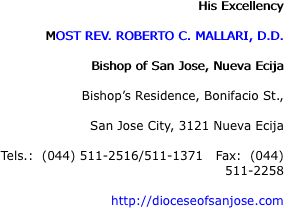The Catholic Bishops' Conference of the Philippines
The Official Website of
CBCP Online

The land area covered by the diocese is 2,540 square kilometers with a population of 594,750 of which 80 per cent are Catholics. The titular patron is Saint Joseph, whose feastday is celebrated every March 19. The diocese now has 17 parishes administered by 22 priests working under one bishop. Among its Catholic institutions are 9 high schools, 4 elementary schools, 6 kindergarten schools, 1 diocesan catechetical center, and the Don Bosco Training Center.
On July 14, 1984 the Most Reverend Florentino F. Cinense was made the First Residential Bishop of the Diocese of San Jose, Nueva Ecija. When he was later appointed Co-adjutor Bishop of Tarlac, he remained as Apostolic Administrator of San Jose until the appointment of his successor. On July 25, 1987, the Most Reverend Leo M. Drona, SDB, was appointed Second Resident Bishop of the Diocese of San Jose. He was a Salesian of Don Bosco for twenty-nine years prior to his episcopal appointment. He was the first Filipino Salesian priest, and is now the first Filipino Salesian Bishop.
San Jose is one of the three major cities in Nueva Ecija, a province landlocked in the area of Central Luzon referred to as Region III. This area, also called the Central Plains of Luzon, is known as the rice granary of the Philippines as it produces one-third of the country's rice supply.
Originally Nueva Ecija was part of Pampanga until the year 1705, when the Spanish Governor Fausto Cruzat declared it a separate province. The name of the province has its origin from that of Ecija in Seville, Spain, which was the hometown of Governor Cruzat.
When the territories of Nueva Ecija and Tarlac were first explored during the early days of the Spanish occupation, these were found to be sparsely populated compared to Pampanga, Bulacan and Bataan, the neighboring provinces. With the clearing of the land however, the population increased considerably and went into intensive agriculture. The main crop today is rice, but Nueva Ecija is also a main source of mangoes for the Luzon area.
Historically the province of Nueva Ecija, like its sister provinces in Central Luzon, was among the first to proclaim itself at war with the Spanish government in the Revolution of 1898. The town of San Isidro, one of the southern towns of the province, also served as a temporary seat of the Philippine Revolutionary Government. In this century, after Philippine independence, the province of Nueva Ecija once again became a battleground, this time between the Philippine Army and the Hukbalahaps, a communist-backed agrarian movement.
The Diocese of San Jose was created on February 16, 1984 by Pope John Paul II, comprising the city of San Jose and thirteen of the northern towns of Nueva Ecija. The creation of the new diocese bisected the province horizontally into the Diocese of Cabanatuan in the south, and the Diocese of San Jose in the north, both them suffragans of the Archdiocese of Lingayen-Dagupan.
|
Diocesan Curia |
|
Clergy |
|
Parishes |
|
Educational Center |
|
Institutions |
|
Statistics |

Diocese of San Jose, Nueva Ecija

